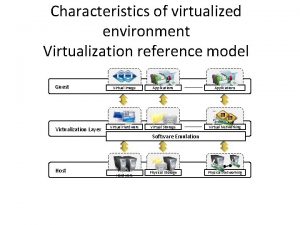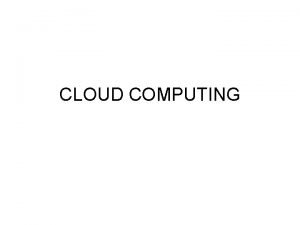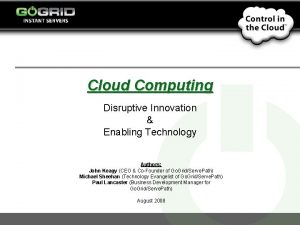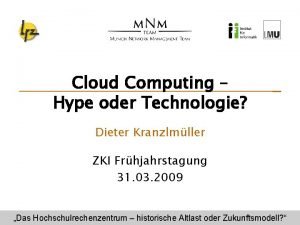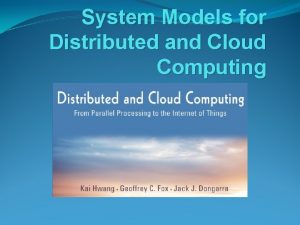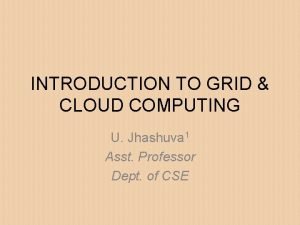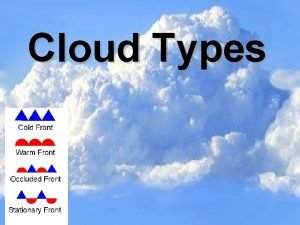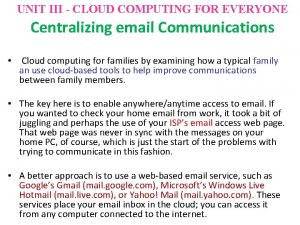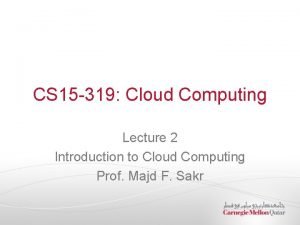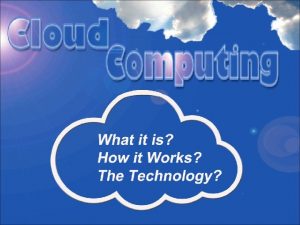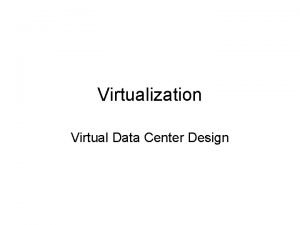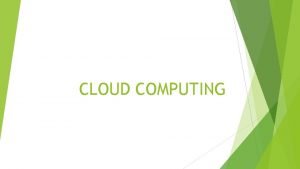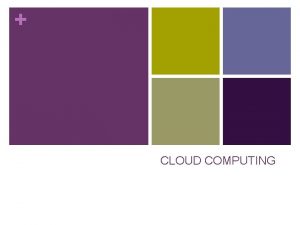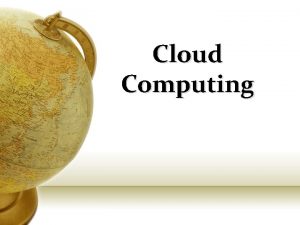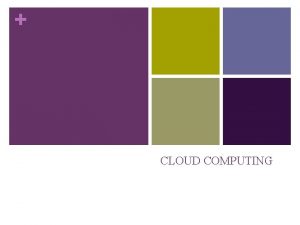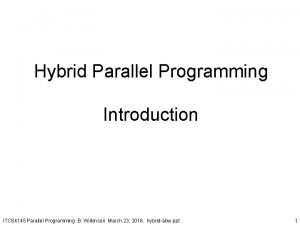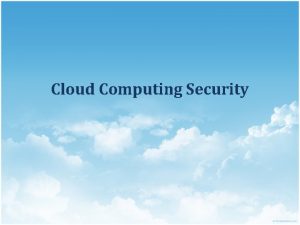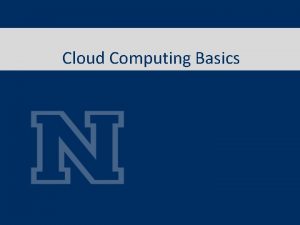Cloud Computing CSCI 4145 CLOUD COMPUTING CSCI 5409















- Slides: 15

Cloud Computing CSCI 4145 CLOUD COMPUTING CSCI 5409 ADVANCED TOPICS IN CLOUD COMPUTING Initial reference points http: //cs. dal. ca/~fabbas/csci-4145 http: //cs. dal. ca/~fabbas/csci-5409 Faisal Abbas fabbas@cs. dal. ca

Origin and Influences A Brief History Time Sharing Driver - Cost ◦ 1954 – John Backus ◦ 1959 – John Mc. Carthy Described Implemented ◦ 1961 - John Mc. Carthy Described - Utility Computing 1970 s – 1980 s Cost reduction-Miniframes Driver – Cost 1990 -2000’s started Internet based Utilities Value ◦ Search Engines (Yahoo!, Google) ◦ Open Publishing ( Myspace, Facebook, You. Tube) Driver – Email Services (Hotmail, Gmail) Social Media (Twitter, Linked. In)

Adoption Late 1990 s ◦ Salesforce. com pioneered ◦ Remotely Provisioned Services into enterprise 2002 ◦ Amazon launched Amazon Web Services (AWS) Platform 2006 - Term Cloud Computing was adopted Amazon Elastic Compute Cloud (EC 2) – Leasing 2009 – Google Apps Engine

Cloud Computing ARPANET Internet Network Cloud(s)

Term – Cloud Computing Cloud as a Metaphor for Internet 1996 – Compaq Computer - George Favaloro & Sean O’Sullivan coined “Cloud Computing” 2006 – Google CEO Eric Schmidt “I don’t think people have really understood how big this opportunity really is. It starts with the premise that the data services and architecture should be on servers. We call it cloud computing—they should be in a “cloud” somewhere. ”

Definitions Gartner ◦ “…a style of computing in which scalable and elastic IT-enabled capabilities are delivered as a service to external customers using Internet Technologies” Forrester ◦ “… a standardized IT capability (services, software, or infrastructure) delivered via Internet technologies in a pay-per-use, self service way. ”

NIST Definition (Most widely accepted) Cloud computing is a model for enabling ubiquitous, convenient, on-demand network access to a shared pool of configurable computing resources (e. g. , networks, servers, storage, applications, and services) that can be rapidly provisioned and released with minimal management effort or service provider interaction. …”

Business Drivers Capacity Planning ◦ Lead Strategy ◦ Lag Strategy ◦ Match Strategy Cost Reduction ◦ Capital Expense ◦ Operating Overhead Organizational Agility

Technology Drivers Technology Innovations ◦ Clustering ◦ Grid Computing ◦ (Advanced) Virtualization Enabling Technology ◦ Broadband Network and Internet Architecture ◦ Data Center Technology ◦ (Modern) Virtualization Technology ◦ Web Technology ◦ Multitenant Technology ◦ Service Technology

Basic Concepts and Terminology Cloud ◦ Distinct IT Environment that is designed for the purpose of remotely provisioning scalable and measured IT resources (NOT The Internet) IT Resource ◦ Physical Server ◦ Software Program ◦ Storage device Virtual Server Service Network device

. . Basic Concepts and Terminology On-Premise (IT Resource) ◦ Conventional ◦ Within Organizational Boundary ◦ Can interact with cloud based IT Resource ◦ Can be moved to cloud ◦ Can be redundant deployment on both On-Premise and cloud-based Cloud Consumers Cloud Providers

. . Basic Concepts and Terminology Scaling ◦ Horizontal Scaling – Scaling out and Scaling in ◦ Add more ◦ Complex to plan ◦ Vertical Scaling – Scaling up and Scaling down ◦ Use Better ◦ Easy to plan

. . Basic Concepts and Terminology Cloud Service ◦ IT Resource remotely accessible via cloud Cloud Service Consumer ◦ Temporary runtime role ◦ Software program

Goals and Benefits Reduced Investment ◦ On-demand access Pay as you go Proportional Costs ◦ Proportional to Business Activity ◦ Not necessary Less Increased Scalability ◦ Peak Usage Increased Availability and Reliability On a short-term basis

Risk and Challenges Increased Security Vulnerabilities Reduced Operational Governance Control ◦ SLA’s (Harder to manage) ◦ Contractual Boundaries Limited Portability between Cloud providers (Vendor Lock-in) Multi-Regional Compliance and Legal Issues ◦ Geography ◦ Legal Boundaries ◦ Accessibility and Disclosure
 Seven step model of migration into cloud
Seven step model of migration into cloud Conventional computing and intelligent computing
Conventional computing and intelligent computing Reference model of full virtualization
Reference model of full virtualization Cloud computing value proposition
Cloud computing value proposition Oracle cloud computing strategy
Oracle cloud computing strategy Syarat cloud computing
Syarat cloud computing Cloud computing as a disruptive technology
Cloud computing as a disruptive technology Grid and cloud computing lmu
Grid and cloud computing lmu All resources are tightly coupled in computing paradigm of
All resources are tightly coupled in computing paradigm of Grid and cloud computing definition
Grid and cloud computing definition Cloud types
Cloud types Tudulist
Tudulist Cmu cloud computing
Cmu cloud computing App.gis-div/pcs web
App.gis-div/pcs web Cloud computing network topology
Cloud computing network topology Levels of virtualization in cloud computing
Levels of virtualization in cloud computing


